REVIEW: Abraham Riesman’s excellent, well-researched book True Believer illuminates a tarnished legend…
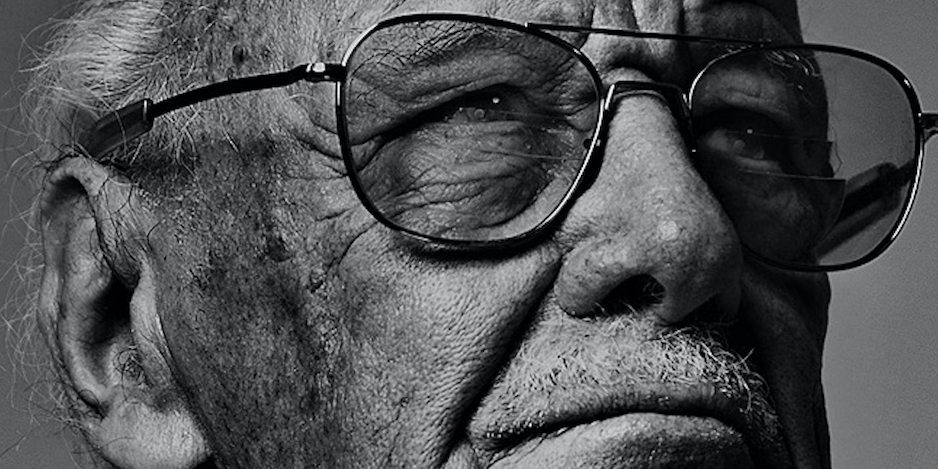
13th Dimension columnist Fred Van Lente is a comics writer, historian, and playwright, who has chronicled the relationship between Stan Lee and Jack Kirby in the play King Kirby, written with his wife Crystal Skillman.
While he’s a Kirby admirer, he’s more interested in historical truth than opinion – making him a prime choice to review Abraham Riesman’s newly published True Believer: The Rise and Fall of Stan Lee. — Dan
—
By FRED VAN LENTE
I grew up on the words of Stan Lee. As a kid in the 1970s, I devoured the Pocket Books reprints of the original runs of Fantastic Four, Hulk, Doctor Strange and Amazing Spider-Man. Lying beside my laptop as I type this is my childhood copy of his Origins of Marvel Comics, still covered in my toddler marker scrawlings.
The 1974 cover of that book pretty much sums up the myth of Lee, as brought to life in my mind: Lee’s fingers hammer at a typewriter, from which spring all your favorites: Thor! The Thing! Human Torch! Sub-Mariner! They all came from him! And only him! After all, “Stan Lee” is the only name of the cover!
Between the covers, Lee tells us in his trademark bombast how he came up with a bunch of high-concept superheroes — Monster Superhero! Teen Superhero! God Superhero! Blind Superhero!, etc. — that were then brought to visual life by his trusty sidekicks, artists like Jack Kirby and Steve Ditko. Being in his authorial presence was so much fun I didn’t really question that he was the one and only “Man.”
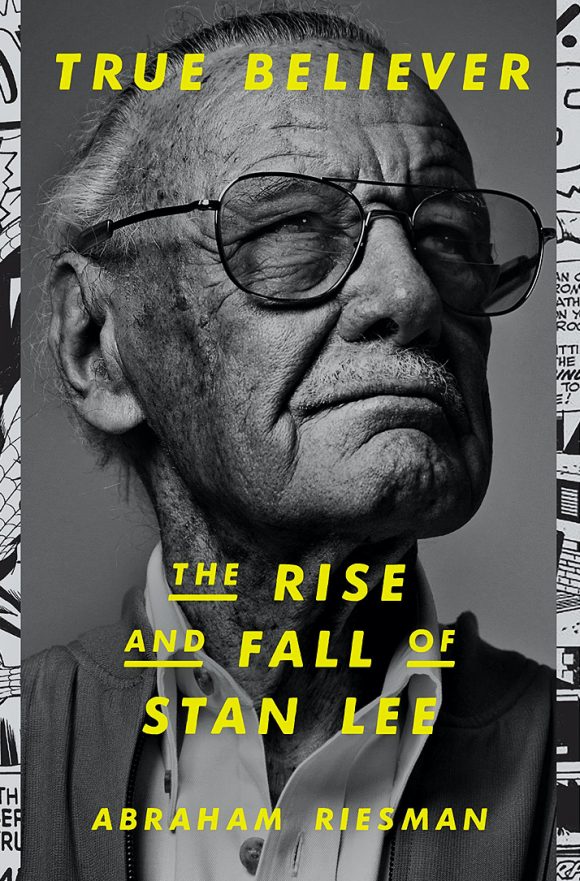
But as Abraham Riesman entertainingly explains in his new biography True Believer: The Rise and Fall of Stan Lee, the truth is that the greatest solo creation of the man born Stanley Lieber was “Stan Lee,” the omnipresent avuncular editorial voice of Marvel Comics, believed by the brass to be such an essential part of the company’s success that even after he left they slapped “Stan Lee Presents” at the beginning of every one of their titles, even ones, like Star Wars and GI Joe, that never had a thing to do with him.
I pulled out Origins of Marvel Comics as a refresher to write this review and realized for the first time that the cover features two Lee-appropriated Golden Age stalwarts, Human Torch and Sub-Mariner, that were absolutely created by other people (Carl Burgos and Bill Everett, respectively) long before Lee even began working at Marvel. That’s partly why the Stan Lee Myth is so frustrating to us non-believers: It only takes the slightest tug at the seams to make the whole thing unravel.
Honestly, though Riesman has brought, as the kids say, receipts, the first part of True Believer and the opening to Origins of Marvel Comics tell basically the same story, that of a dissatisfied functionary at a relative’s second-rate comic book company desperately trying to figure out some side hustle to bring him fame and fortune. But then he accidentally stumbles into that fame and fortune at his day job, when Jack Kirby draws Fantastic Four #1 for him, making the publisher a cultural phenomenon in the 1960s, and Lee its public face.
Where True Believer and Origins radically diverge, as one would expect, is that when Lee is no longer the sole arbiter of the Marvel story, his role becomes re-contextualized in a little thing we used to call “reality.” For example, Riesman goes further than most cultural critics to point out that there is absolutely no real evidence that Stan Lee had anything to do with the creation of Fantastic Four #1 other than maybe the direction to Jack Kirby, “do a team superhero book.” (Granted, Jack Kirby’s story of how he came up with it solo doesn’t hold water either, but we know he, you know, drew it.)
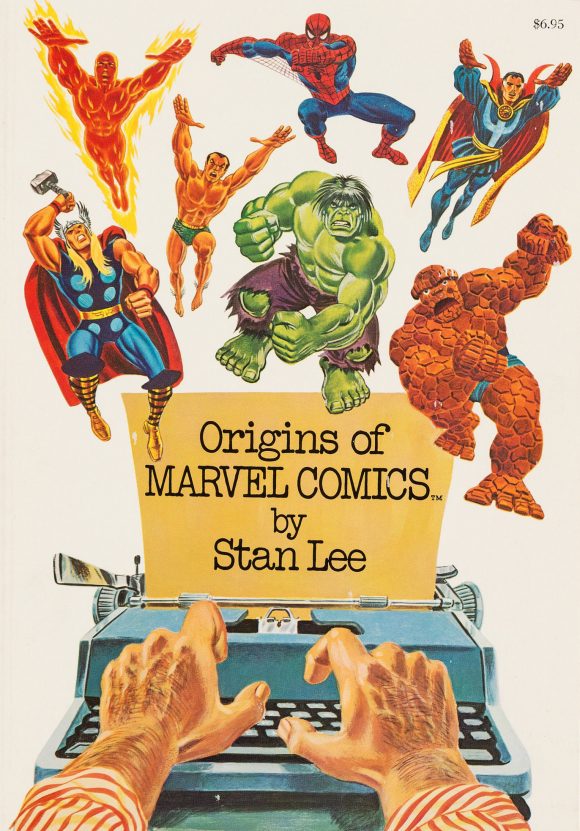
The most famous sequence in Amazing Spider-Man was 100 percent the doing of Steve Ditko. Wally Wood quit Daredevil once he realized he was coming up with all his own stories and Stan Lee was taking the credit—and the money!—for it.
So when I say I grew up on the “words” of Stan Lee, I was being specific. He created very little by the way of stories and characters; his artists took care of that. Lee added the words in the lettering once the comics pages already came in, already plotted, ensuring that his editorial voice would dominate.
Now, don’t get me wrong: That is not nothing; in fact, I would very much agree that his style was a major contributing factor to Marvel’s success.
But the truth is, Marvel’s artists were not Lee’s sidekicks: He was theirs. Yet he got all the glory of the title hero.
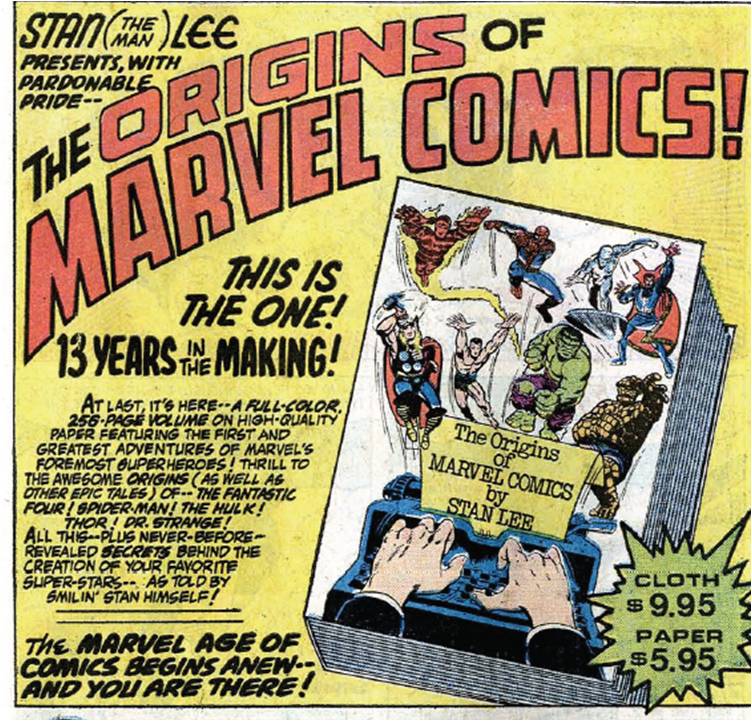
The status quo sorted itself out by the end of the decade: Artists who were cool with Stan’s “Marvel Method” stayed and thrived at the publisher: John Romita Sr., John Buscema, Gil Kane and many others. Those who got fed up playing second fiddle, quit: Wally Wood, Steve Ditko, and ultimately, Jack Kirby. Marvel produced a lot of great characters, but they could have also had Darkseid, Orion, the Demon, Mister Miracle, the Question, Kamandi, OMAC, Captain Atom, Hawk and Dove, the Creeper, and even the THUNDER Agents, plus countless unrealized others, had Lee (and, to be fair, the American comic book industry as a whole) learned how to share credit.
Kirby stuck it out the longest; he had created the most, so he had the most to lose by breaking with the company. (Tellingly, Lee left Marvel not long after Kirby, likely realizing the goose with the golden eggs had flown the nest. Riesman wisely spends little time on Lee’s second, post-Marvel, period of fruitless hustling, mostly in Hollywood.)
I’ve been fascinated by Kirby’s story for decades; my wife and I wrote a play about it, King Kirby, which, since you brought it up, has gotten the full audio drama treatment from Broadway Podcast Network. You can download it for free here.
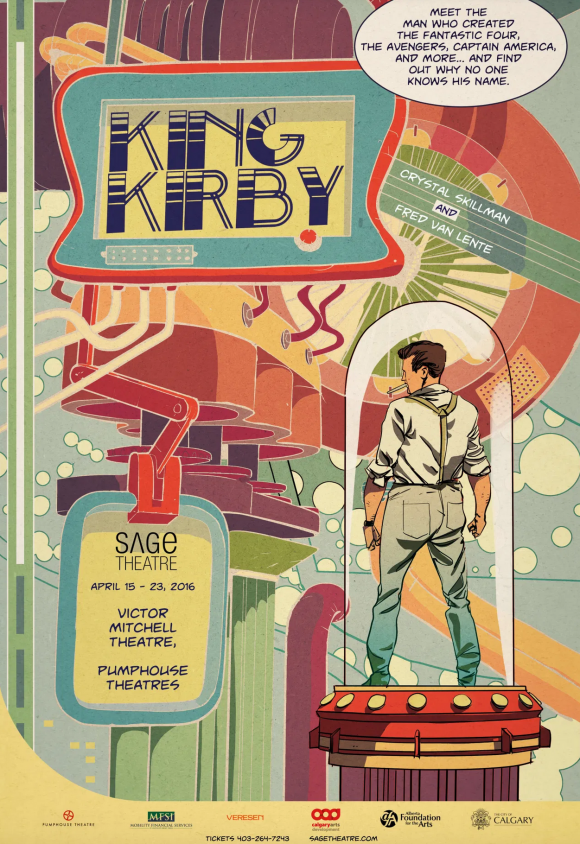
Riesman’s excellent book has two flaws. The first comes at the very beginning, which is an exhaustive (and to this reader, tedious) Kavalier & Clay–style deep dive into the Romanian-Jewish origins of Lee’s family. As Riesman himself later makes abundantly clear, Lee militantly ignored these origins his whole life (in marked contrast to, sorry, Jack Kirby). They are germane only if you give equal weight to what people “are” as to what they do. There seems to be a vague attempt to tie Lee’s hucksterism to a larger Jewish tradition of… something, something, but that amounts mostly to hand-waving instead of a reasoned argument.
The second, bigger knock doesn’t stem from the author, but his subject. The “Fall” part of the book is as long as the “Rise” part and deeply depressing. I used to think you could demarcate Lee’s life between the decade-long fertile period working with Kirby and the fallow periods before and after, but Riesman has made me see that there is a second, equally important dividing line, which is Ang Lee’s Hulk (2003), the first Marvel movie in which Stan Lee actually has lines.
Once “The Stan Lee Cameo” became something anticipated by millions of moviegoers worldwide, Lee’s fame leveled-up beyond local-comic-con-headliner and attracted a never-ending parade of parasitic hangers-on. These schemers range from world-class F.O.B. (look it up, non-’90s kids) con-artist Peter Paul, all the way down to guys who don’t deserve a one-star seller’s rating on eBay.
If, like me, you have spent a significant chunk of your adult life at comic book conventions, you have met literally hundreds of these cringeworthy wannabe big-shots. The realization that the most famous person your industry has ever produced let them completely take over his life and rob him blind, well, that’s a huge bummer.
Riesman becomes a significant character in his own book in its latter third, as he tries to report for (in this case, the aptly named) Vulture on the circular firing squad of the still-living Lee’s entourage, which included, most sadly, his wife and daughter. For him, and the reader, it’s like untangling any other ugly family dispute: You exhaust yourself battling trivialities.
Kirby and Ditko partisans who took dark glee in watching their nemesis get ripped off by hucksters vastly more venal than he ever was should have their Schadenfreude cured by Riesman’s harrowing account: this is not-even-on-my-worst-enemy stuff.
Lee has his partisans too, of course, and on Twitter, Riesman has shared the death threats, shit-posts and Facebook hate he’s received – before the book was even published. If the last few years have taught us nothing else, it’s that many, many people hunger to believe in someone, anyone, as a Great Leader, and will attack anyone who says otherwise, not on the basis of opposing facts, but on the basis of opposing Belief, that you’re desecrating their personal religion.
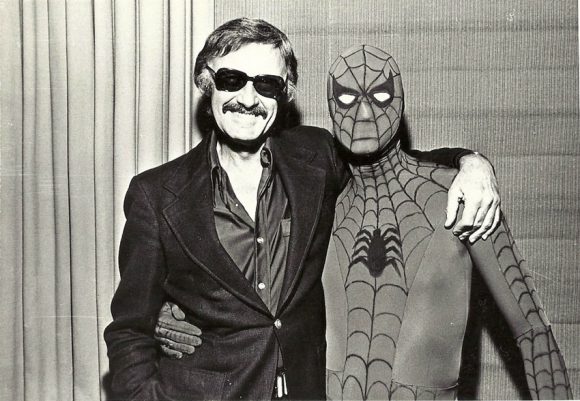
“Stan Lee just wanted people to be happy,” they say, as if he was Santa Claus, and good intentions make it OK that Santa took sole credit for creating all those toys… when all he did was deliver them, right?
Friends, vaccines don’t cause autism, Antifa didn’t attack the U.S. Capitol on January 6, and Stan Lee did not create the Marvel Universe. I am old enough now to know that those of you who need to hear this message will ignore it, and for those you who already knew it, True Believer: The Rise and Fall of Stan Lee is more of a reminder than a revelation. But it is extremely well researched, well reported, and well written, and I devoured it in a single (five-hour-ish) sitting. I bet a lot of you will too.
And, once again, if you want another side of this story in historical drama fashion, listen to King Kirby on Broadway Podcast Network.
I know, I know. It’s probably a little crass to plug my own stuff while reviewing another guy’s book. But what can I say?
I grew up on the words of Stan Lee.
—
True Believer: The Rise and Fall of Stan Lee is out now from Crown. It lists for $28. You can also click here to purchase King Kirby in paperback.
—
MORE
— LEE, KIRBY and the Case of Who Created the MARVEL UNIVERSE, by JOHN MORROW. Click here.
— To JACK KIRBY’s Fans: We’re Better Than This, by JOHN MORROW. Click here.

February 20, 2021
Interesting how Kirby, Ditko and Wood got short shrift from the world at large for their contributions to the Marvel Universe in much the way Bob Kane took all the credit for Batman when we now know Bill Finger created most of what we know of the character. I appreciate Stan Lee’s talent and vision but am glad the people who’ve been neglected for their creative input are starting (just starting in the larger world view) to get their due.
February 20, 2021
I totally agree!!!
March 16, 2022
Extremely well written my friend.
I too, have always given credit to the illustrators of those awesome comics. One of my favorites is Ross Andru His style was unmistakable as Spider-man himself donned his costume with Stan Lee.(Note the triangular
spider-eyes).
This is how Ross drew him. Ross also had the pleasure of penciling [THE BATTLE OF THE CENTURY: SUPER MAN vs THE AMAZING SPIDER-MAN].j You would just have to check out interviews with the artists themselves about their notable contributions. I can assure you, it’s much more than meets the eye.
February 20, 2021
“So when I say I grew up on the “words” of Stan Lee, I was being specific. He created very little by the way of stories and characters; his artists took care of that. Lee added the words in the lettering once the comics pages already came in, already plotted, ensuring that his editorial voice would dominate.”
I would argue that you are shortchanging Lee’s contributions. Remember the stories of Lee’s “plotting sessions” where he and the artist would hash out what would happen in the next issue, with Lee standing on the desk, acting it all out? Look at Kirby and Ditko’s solo efforts for a mass audience. Not only are they few, but they are often muddled and confused, and lack that “I can’t wait to read the next installment” vibe that Stan’s comics had in abundance. Even the Fourth World, as imaginative as it is with its concepts, is sorely lacking in actual STORY.
The hard, honest fact is that the greatest successes of Lee’s writing era at Marvel are in collaboration with a few stellar storytellers. But a storyteller is only as good as the story he is telling.
February 20, 2021
Those accounts of plotting sessions were described by Lee himself, and have since been revealed as mostly fiction. The artists did virtually all of the plotting.
Consider, for example, FF 48-50, almost half of which is dominated by the Surfer, even though it is common knowledge that Lee had no idea that Kirby had created him. How could Lee have plotted a story dominated by a character of which he was unaware? The obvious answer is he didnt.
February 21, 2021
I have no idea of who did what and I am not going to enter that argument, however as to your question of how Kirby could put the Surfer into the book without Stan knowing, if Stan had plotted it? Simple, Kirby was inspired while he was doing the job and Stan liked the Surfer so much, he kept him. Once again, I have no knowledge of what did, or did not happen; I am simply illustrating ONE scenario that answered your question.
February 21, 2021
Those plotting sessions have been described from everyone from Flo Steinberg to Marie Severin. You can’t open a Marvel-related issue of Alter Ego without reading someone’s account of them. Lee could have easily loosely plotted those stories, without including the Surfer. I am not saying he did all the work, but he deserves at least half credit.
And no one stopped, ever, Kirby or Ditko from blowing their own horn. They were seemingly happy to let Lee take credit. Ditko wanted NOTHING to do with any kind of fan press, and Kirby, honorably, kept his nose down and let his work do his talking. And, again, when he was free of the “burden” of Lee’s writing, it was evident that he didn’t have the knack for story that Lee did.
You can’t throw a cat without hitting a book about how Kirby was abused by the system for 40 years. I think he would be disgusted by them. He was not a victim, and to portray him that way does him a disservice. He was a smart, talented guy with a lousy business sense. He was too busy, on a daily basis to see the long game. He busted his ass to put food on his family’s table, glory or not.
February 23, 2021
It’s fine that Lee did the dialogue for all the stories and became a sort of Master of Ceremonies. The down-side is the lack of credit for the one’s doing the art and secretly concocting the plots, though it’s probable the cult atmosphere would’ve probably diminished but then Stan wouldn’t have to work so hard to look like some celestial titan of the Marvel bullniverse(excuse me,”bullpen.”) Excelsior, True Ex-Bullievers!
April 7, 2021
John Romita has described such sessions, and IIRC, Flo Steinberg as well
February 20, 2021
I agree. This is the first time I’ve heard anyone challenge Kirby and Ditko’s contributions. Yes, they deserve more credit than they got but look at their creations without Lee. Eternals, Fourth World and characters that became the Watchmen went nowhere. Until those characters were developed by writers they were dull and uninspired.
February 20, 2021
Kirby’s work can be followed and so can Ditko’s non self published work with a few exceptions. Even Shade The Changing Man was not hard if you paid attention. Not sure if people are really following the story. Blue Beetle and the Creeper are also good Ditko written comics.
February 21, 2021
Ditko plotted the Blue Beetle comics, and someone else scripted them He plotted only the first issue of Beware the Creeper, and Denny O’Neil scripted it, and O’Neil wrote the scripts for the rest of the run.
August 15, 2021
Mike Friedrich wrote the scripts for the earliest Ditko Blue Beetle stories; after that, Ditko scripted the stories under D. C. Glanzman’s name. As for the Creeper, after the initial run in the 60s, Ditko had another Creeper run from 78-79, a World’s Finest backup series where illustrated, plotted, and scripted the whole thing himself.
February 22, 2021
I agree. If you compare the Lee/Kirby collaborations of the 60s with Kirby’s solo work in the 70s, there’s a better sense of cohesion and storytelling with the former works. There’s no doubt that Kirby was an incredible idea man, but his solo work has a stream of consciousness feel that doesn’t really drive the story from one issue to the next. Characters and concepts are introduced in one issue only to be abandoned for some other character or concept in the next. The New Gods and Forever People issues are particularly meandering. Writing is not entirely about big ideas but also driving the narratives in a way that feel satisfying for the reader.
March 2, 2022
“Even the Fourth World, as imaginative as it is with its concepts, is sorely lacking in actual STORY.”
It, in fact, tells multiple stories, stories brimming with so many ideas, meaning and character that continuously fly over the heads of predictably un-curious and shallow superhero readers. The way I see it, at a generational remove from the time period these comics came out of, Kirby was a great writer whose works were being read by and targeted to the wrong audience. I’m now seeing evidence of people even younger than me discovering and appreciating these comics. They may not be in mass numbers, but they are growing, and will hopefully point the way to the future of Kirby’s reputation as a true author.
February 20, 2021
It is disappointing to learn the behind the curtains about the people who’s creations brought me so much joy as a shy, introverted kid in the 70s early 80s – and that work STILL brings me joy as a world-travelled adult in my 50s.
But it is a part of reality that in addition to their talents, they were also business people and getting paid to do a job. The work they produced day in and out likely did. It have the same meaning as it did/does to us kids.
It is too bad that the credit and compensation for all of them was not shared appropriately and that after their deaths is when those things get noticed. And the changing times of royalties and proper credit.
I hope that their actual work will continue to inspire and delight future generations of children (of all ages) through reprints and with new stories that honor the original creations.
Thanks for this review and your personal connection to it.
February 20, 2021
Wondering if this excellent site will publish a rebuttal to this piece, or at least a perspective from someone who is not entering the arena as a Kirby partisan (or promoting some sort of financial stake in representing the Kirby story–I wonder if royalties are being paid to the Kirby estate for the radio show…).
February 20, 2021
Yeah, bashing Stan has become trendy over the last decade or so. It’s a shame, because Stan was every bit as important as Kirby and Ditko. His general ideas that were so out of left field made Marvel unique and different from DC, and that’s why Marvel became MARVEL.
February 20, 2021
I grew up understanding there was a creative process going on and it took many hands. It seemed natural to me that it had to be this way. Lee himself gave me this impression when he gave the other creators their jazzy titles like “the King”, you just knew things were being done together. If anything I was disillusion when I realized they weren’t all working out of the bullpen.
Personally I think comic creators should be licensed same as music producers. The whole team should share. How music went one way and comics the other, I have no idea.
February 21, 2021
I hate to say it, but music producers make a terrible analogy to this situation. Many of them took credit for their artists’ work, particularly when they put their names on a song as co-writers and, in many cases, took the lion’s share of the music publishing. And abuses are still going on in that industry, as evidenced by issues raised by Taylor Swift and others.
But speaking of sharing… One thing that hasn’t been mentioned in these comments is that Stan started a trend of listing the credits for who wrote and drew a particular story on the splash page of that story. The credits were gradually expanded to include the inker, the letterer, and eventually, the colorist. Admittedly, when Stan moved from writer to editor, he always put his name first; those who followed him in the editor’s role put their names last. But it was started in those early books, and slowly adopted by other comic companies. If Stan really wanted to hog ALL the credit for himself, I don’t think he would have done this.
I have Riesman’s book on order and I intend to read it with an open mind. However, I’m not prepared to exclude Stan from credit for the Marvel characters.
February 22, 2021
My use of the term “music producer” was a mistake, I should have said something like “creators of music”. I was trying to convey how rights are divided up amongst the creative team. I simply don’t see how the two (comics & music) are treated so differently. Those guys (Ditko, Kirby & Stan) should have enjoyed royalties off their work in whatever form it took. Like you I will also be getting the book and I doubt seriously it will change my broad opinion of how they were all working together in some capacity. But I do enjoy a good read……
February 20, 2021
I remember Stan Lee mainly as a co-creator for the Marvel Universe.
February 20, 2021
The idea that Stan did little when it came to creating the characters is false. Sure, the details were handled by Kirby and Ditko, but Stan had the broad, general ideas that were WAY different from what was the norm at the time. DC would have never had a superhero team that was, essentially, a dysfunctional family (FF). And DC would have never allowed for a teenager to be the headliner – teenagers were sidekicks! Those were Stan’s ideas. Plopping Peter Parker down in the same New York suburb that Stan grew up in and giving him the kind of problems that a lot of kids faced (getting bullied, teased, and even tormented by his peers) was unheard of in comics at that time. That was Stan.
So, ABSOLUTELY Kirby and Ditko played HUGE roles in the creations of those characters, and they took his vague, loose plots like, “In this issue I want Spider-Man to get sick and lose the fight to Dr. Octopus and be unmasked,” and fleshed them out into actual stories. But the ideas – the general, vague ideas that made Marvel so different from DC – usually came from Stan.
As a society, we seem to LOVE tearing down our heroes. Babylon 5 spent an entire episode on that subject (“The Deconstruction of Falling Stars”). We love to build people up, and then tear them down.
It is a fact that without Stan Lee Marvel Comics as we know it would have never happened. His ideas that were so different from what was accepted at the time helped Marvel to stand out. Jack and Steve made HUGE contributions, just as important as Stan’s, sometimes moreso, but without Stan’s groundbreaking ideas Marvel would not have become MARVEL.
February 20, 2021
How do you know the original ideas were Stan’s? Please if there is information that points it has not come up.
February 20, 2021
What does John Romita Sr. Have to say about Stan Lee?
February 21, 2021
He also has admitted a few times that Lee had him plot entire issues of Spider-Man himself. Romita never cared. It does seem that Lee would changes after the story came in.
February 21, 2021
I’ve been a supporter of creator rights & recognizing the contributions of Jack Kirby, Steve Ditko & others since the early 1980s, when I first read about Jack Kirby’s plight in The Comics Journal. In other words, I’ve always been in the Kirby/Ditko camp. They were treated horribly and never received the financial compensation they deserved. Other people got rich over their creations and they got pennies. That is just a fact. And Stan Lee got more credit than he deserved. I was always annoyed when I would see Stan sign Captain America shields – Stan Lee had nothing to do with creating Captain America.
That being said, I think this article goes too far. Stan was a co-creator. Whatever his actual contributions to individual stories, the Marvel Universe does not exist without him. Part of the problem is that Stan is victim of the “Marvel Bullpen” mythology that he created to sell comic books – the idea that they were all one big, fun gang working in a bullpen; creating comics for the “true believers” – all masterminded by Stan Lee. The truth was Stan was no mastermind. But, the Bullpen didn’t exist either – it was a fictional construct. And Stan was the showman, the manager, and a visionary. He also certainly contributed ideas but to what extent, we will never know for sure.
The fact is that when the “Marvel Age” began, no one cared about the credit. They were just interested in creating a product that sold and staying afloat another month. It’s only become an issue decades later because superheroes have become big business. And that is where the true villainy lies. Jack Kirby and Steve Ditko got pennies for their creations. Stan Lee did a little better – he got a nice pension. But, Martin Goodman got millions and Disney got billions. And they didn’t create a damn thing.
February 21, 2021
The last part is not entirely true. The were doing most of the writing for Lee and not getting paid. Credits or not that was a issue that would not sit well.
Second how does one know he was co creator outside of dialogue if we do not have evidence?
February 21, 2021
Fred, I’m glad you liked the book… after the Salkowitz panel at SDCC, I wasn’t sure which way you would take it. But in the context of your review, what in the world would prompt you to write this? “Granted, Jack Kirby’s story of how he came up with it solo doesn’t hold water either, but we know he, you know, drew it.”
Myself, I loved the Romanian Overture.
February 22, 2021
Not that different from Disney who’s name appeared on his work when most of it was done by his artists.
February 22, 2021
Just one caveat clearing up an error in this review. You state Stan Lee left Marvel shortly after Jack Kirby. I say true t Lee left editorial stuff but in turn by 1974 ish is becoming *publisher* of Marvel for the owners of CIA front org Perfect Film and Chemical which in turn was name changing to Cadence Industries. That is if my memory cells are still partially functioning correctly
February 24, 2021
In 1972 I self-published three comics of Steve Ditko’s work, and I talked to him at length in person several times, and one time I said to him, “I am wondering about something.
I have read a LOT of the pre-hero Marvels, and I notice that the stories you did seem similar to each other, and the ones Jack Kirby did seem similar to each other.
I feel like I could pick out which ones you did or Kirby did solely by the writing, and yet they all say ‘written by Stan Lee’. Why is that, and how much writing did Stan do?”
And Mr. Ditko said to me, “Stan didn’t do much. Sometimes he might say, ‘Do a story about a tree monster’ or ‘Do a story about a rock monster'”
In every way I always found Mr. Ditko to be completely truthful with me, and what he said that day makes me always ponder whenever I see “written by Stan Lee” printed in a comic book.
February 24, 2021
Lee became Marvel’s publisher in 1972, at which point he stopped writing monthly comics. He had already stopped writing anything but Spider-Man and Fantastic Four. (Roy Thomas was the first editor-in-chief after Lee.)
Stan moved permanently to California in 1980 and devoted himself to pitching Marvel characters to movie and TV producers — an effort that was unsuccessful for many years, aside from some cartoons and B movies.
Stan’s writing of dialogue and captions gave Marvel a lot of its flavor in the ’60s, as much as the art. He was also a brilliant editor. Lee became the “face of Marvel” sort of by default; Ditko was a recluse who didn’t attend conventions or give interviews, and Kirby tended to get tongue-tied when he tried to explain what he did. But Lee was a glib, walking quote machine. Someone had to talk to the press, and Stan was the obvious choice.
February 26, 2021
The Lee-Kirby-Ditko issues in Riesman’s book are nothing new. These disputes were aired in Comics Journal articles more than 30 years ago, and in books such as Sean Howe’s excellent “Marvel Comics: The Untold Story” and Danny Fingeroth’s Lee biography.
But none of this earlier work had the mainstream media push that Riesman’s book is getting, including long essays in The New Yorker and the Washington Post. The reason, I’d guess, is Marvel’s current dominance of pop culture (only Star Wars comes close). It’s now impossible to ignore Marvel and its impact, as much as we might like to ignore it.
March 20, 2021
A few points from a dotard.
1. At least as a youth, Lee’s scripting (which is just the words of the page and have nothing to do with who plotted the story) was a huge breath of fresh air. Unlike just about every other book, it had wit.
2. Lee was the editor. Free to contribute as he wished. Nothing went out without his OK. And arguably the best editor of the 50s and 60s. Certainly up there with the best. As someone noted above, look at what Ditko and Kirby did away from Lee. Always felt that protean as he was — and no one ever came close — Kirby needed an editor. As for the 50s, while the line had a lot of dreck, it had Hank Chapman’s writing and a lot of great art. Ponder this: Lee attracted and,, for the most part, was able to work with a huge number of talented artists.
3. Kirby and Ditko needed no plotting sessions with Lee. I think maybe Wood, too. (OTOH, Wood is a tragedy a little too complex to go into here. Suffice to say, he never came to a bridge he didn’t want to burn behind him.) As Lee admitted at times, essentially Kirby was plotting on his own with maybe something of a head’s up to Lee or a wisp of an idea from Lee. Ditko less so.
4. When it came to promoting, no one could touch Lee. I mean, he’s the one who attracted the writers and to whom the writers were attracted. And at a certain point, Lee became contractually obligated to, let’s say, promote a Marvel-friendly, work-for-hire-supporting version of how things got created at the company. And that first contract is more or less where Lee’s true wealth came from: Bullshitting for bucks. (IIRC, this may have been initially part of Goodman’s sale of Marvel. You know, efforts to ensure that the copyrights are in fact Marvel’s.) Or more bluntly, Lee’s history is laced with corporate bullshit.
5. As for plotting sessions: Romita repeatedly told of at least one Lee-Kirby plotting session. I’m sure there were none with Ditko past a point. Gene Colan was on the record long ago that he had pretty detailed plotting sessions with Lee; I believe those involved a lot of the plot, or story beats, coming from Lee. Romita, I think, was the chief creative on Spider-Man for a couple of years but under Lee’s supervision. Ayers, Heck, et al: No peep of denying plotting with Lee. Ayers, especially, was interviewed a lot in his later years. Plots from writers also started getting more involved, as a rule, starting with Roy Thomas. So the lack of input plot-wise from Lee was the exception for two really talented artists (gross understatement, that).
A few things to keep in mind: Even at Marvel’s smallest while being distributed by DC/IND, Lee’s workload was pretty big: 8-10 books to edit, most of which he was scripting and (co-)plotting and in a context that there was no reason to pay attention of any highly unlikely prosperity. So, missing memories, the corporate fictions.
And as for Kirby, Disney finally did right for Kirby’s family. Of course, as Sir Mick Jagger (a/k/a You can take the boy of the London School of Economics but you can’t take the LBE out of the boy) says at every (rare) opportunity, it’s important for the artist to maintain ownership of their creations. Taylor Swift, famously, did not get that memo. Which is to say it’s great to see that more comics creators have that agency they didn’t have back in Lee’s time.
But a mystery remains for me although I think I’ve seen the answer but hasn’t stuck: One of the last stories fully plotted by Kirby was a riff on, almost a criticism of Objectivism. Lee hated it and did a lot of rewriting in the scripting. So: What was Lee’s problem?
And in closing, Despite fame’n’fortune, Lee’s life at the end was a fucking nightmare that I’d only wish on some but not as a rule. Karma, kids.
March 3, 2022
Thanks for setting down so clearly what’s been in my mind for a long time but never in such simple, reasoned fashion. I would only add that Kirby’s own personality – his desire to remain a free agent, more or less – was a factor in how poorly he was treated. But even so, in that era, NOBODY of his talent and worth to a company like Marvel was ever going to be paid commensurate to his economic value to the owners. They would have had to give him the damn company. I shook my head when i saw Eternals – marvel still mining his legacy nearly 50s years on. He was sui generis, the only one of his species
March 21, 2021
A lot of very informative opinions, but mostly from the uninformed… Read this & those that THINK they are informed just MAY find enlightenment…
https://kupps.malibulist.com/2014/01/26/stan-and-jack-and-steve-and-mort-and-jerry-and-joe/